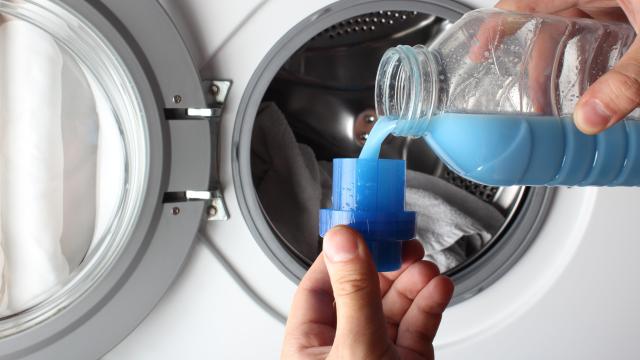We’ve already covered why you should stop using dryer sheets — now it’s time to vanquish the next unnecessary step in your laundry routine: fabric softener. I know, you like how it makes your clothes feel! (And smell.) If you’re a longtime user, you’d be forgiven for thinking in fabric softener’s absence, all your clothes will feel stiff and crusty when you retrieve them from the dryer. But that’s not true. Allow us to share the case against this oft-used laundry staple — and some alternatives.
What fabric softener actually does to clothes
Fabric softener, like dryer sheets, doesn’t actually make clothes softer. Rather, it coats them in a waxy film that provides a surface texture of softness. The problem is, that same waxy film also reduces the fabric’s water absorption, moisture-wicking capabilities and, most importantly, flame-resistance. This is why baby clothes should never be washed with fabric softener. (And what good are soft towels that have lost their ability to perform their primary function: absorbing water?)
The case for avoiding fabric softener
After many washes, the coating builds up and can cause the garment to lose its signature texture and warmth (as in the case of wool). From a health perspective, the Environmental Working Group notes that several of fabric softener’s main ingredients — including “quats” (quaternary ammonium compounds), fragrances, preservatives, colours, and phthalates — can trigger asthma, cause allergies, irritate skin, and potentially disrupt our endocrine system. Over time, the cumulative film build-up also makes it harder for water and detergent to permeate the fabric, making odor and stain removal more difficult. (And speaking of stains, the dyes used in fabric softener have the potential to leave a bluish or grey tint on clothes.)
What are the alternatives to fabric softener?
Create your own: For effective DIY fabric softener, look no further than your pantry. Add a quarter cup of baking soda or a half cup of distilled white vinegar directly into your washing machine’s drum during the rinse cycle to achieve not only softer but brighter clothes. (According to The Spruce, “The acetic acid in distilled white vinegar is so mild that it will not harm washable fabrics; yet is strong enough to dissolve residues (alkalies) left by ingredients in soaps and detergents” resulting in “brighter, clearer colours.” Similarly, baking soda makes whites whiter and colours brighter.)
Aluminium foil balls: While tin foil won’t soften your clothes, it will perform fabric softener’s secondary function — reducing static cling. As clothes tumble against each other in the dryer, they exchange electrons, leaving some with a positive charge and others with a negative charge. (When the dryer stops, those with opposite charges cling together.) According to CNET, tin foil balls “both discharge any static buildup that the clothes may experience and help keep the clothes separated, which should speed up the drying process.”
Wool dryer balls: Where fabric softener creates the illusion of softness, wool dryer balls create actual softness. As they bounce off fabrics, they gently soften the fibres and keep clothes separated, creating a more even heat flow that decreases dryer time. (If you like scented clothes, you can always add a few drops of your favourite essential oil to the balls.)
Air dry: Air drying clothes helps reduce static (not to mention your energy bill), lessens colour fading and shrinkage from heat, and increases the life span of your clothes.

Leave a Reply
You must be logged in to post a comment.